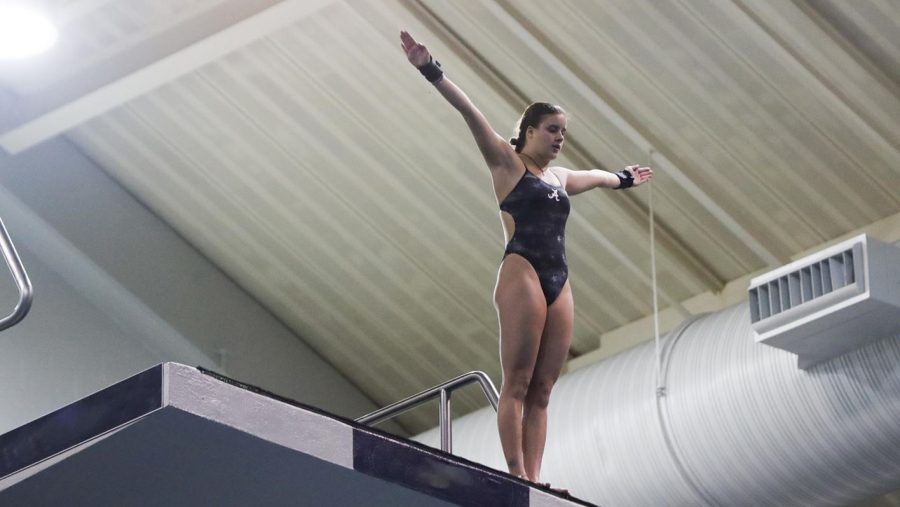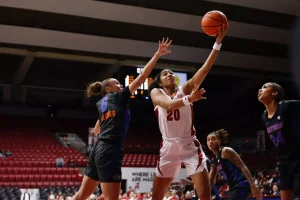Six divers attempt to qualify for national championships
March 9, 2020
Alabama’s swimming and diving teams are two sports that are associated together because of one common denominator: a pool. Other than the pool, though, the fundamentals of the sports are very different, including the scoring, qualifications, coaching and mentality.
“Diving is a tricky sport that requires a little bit of time to fully understand,” coach Rio Ramirez said.
Basics
Swimming is a racing sport. The goal of the sport is to be the fastest in the pool. Athletes compete in events that are comprised of four strokes: butterfly, backstroke, breaststroke and freestyle.
Diving is a sport that evaluates four parts of an athlete’s dive: the approach, takeoff, execution and entry. Athletes dive from a 1-meter or 3-meter springboard and a 5-, 7.5-, or 10-meter platform. Men dive six times at each board and six times off the platform. Women dive six times at each board and five times off the platform.
Scoring
The scoring of swimming is based on how each swimmer places in each event. Each placement is worth a set amount of points. The points earned are tallied and compared to the opposing teams’ scores, and the team with the most points wins the meet.
Divers are judged by a panel of seven judges. They are given a score out of 10. The two lowest and two highest are thrown out. The remaining three scores are added together and multiplied by the difficulty of the dive. The difficulty range is 1.2 – 3.6 and is determined by a formula and the components of the dive.
“The armstand double off the 10-meter platform is my favorite dive right now,” said freshman Tanesha Lucoe, who won the SEC platform title in late February with a school-record score. “The hardest I do is the front three and half pike off the 10 meter.”
An armstand double requires athletes to begin the dive in a handstand position on the end of the platform. The athlete initiates the dive and flips twice before diving into the water.
The front triple pike is started with a diver standing on the platform. The athlete starts the dive and does three and half front flips in a piked position – bent at the waist with legs straight – before entering the water.
Qualifying
Swimmers must reach a certain national ranking or meet a qualifying standard time to make it to the NCAA National Championship. They are able to qualify at any sanctioned meet.
Divers must meet or pass a minimum score at specific qualifying meets in order to attend a zone meet, which is between the conference championship and the national championship.
The scores needed to qualify for a zone championship are below.
Men
1-meter diving: 300 points
3-meter diving: 320 points
Platform diving: 300 points
Women
1-meter diving: 265 points
3-meter diving: 280 points
Platform diving: 225 points
Once qualified for one of five zone meets, they compete there for their one shot at making the roster for the NCAA Championship. If they do not make the cut, then their season is over. However, if a diver qualifies for one dive, then he or she is eligible to compete in all three at the national championship meet. The Crimson Tide is taking six of its seven divers to NCAA Zone B Championship March 9-11 at the University of Georgia.
The six competing are Lucoe and sophomores Hunter Jaynes, Shumpei Komatsu, Kevin Li, Halia Bower, and Natalie Donkle.
The number of divers who advance to the national championship depends on the zone and the event. For men at Zone B, the top 10 on the 1-meter board and the top eight on the 3-meter board and the platform advance. For women, the top seven on both boards and the top eight on the platform advance.
Mentality
Both a swimmer and diver have the mentality to win, but the mental space is different.
A swimmer’s mental space is “amped,” Ramirez said. The athletes are pushing their bodies to go faster than the person beside them. Swimmers build off the adrenaline, anger or excitement.
A diver has to remain calm. The performance of the dive and having only one shot to make the cut is pressure. They are competing dives that involve flips and twists and require strength, body awareness/control and repetition of proper technique. If they were to be in an “amped” mindframe, it could ruin the work they’ve put in.
“Diving is a high intensity sport because your life is in danger most of the time,” Ramirez said.










